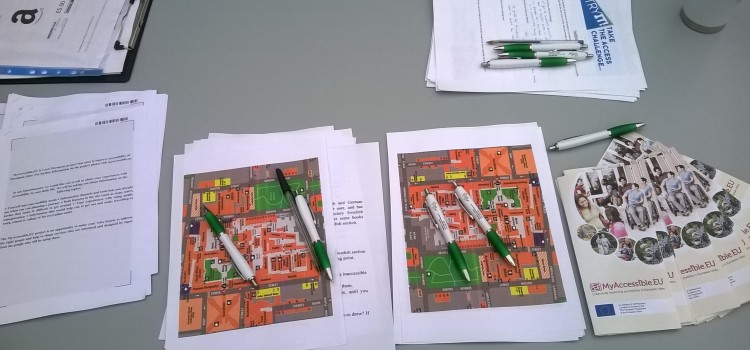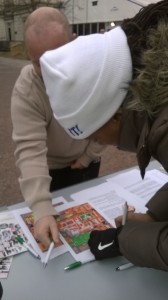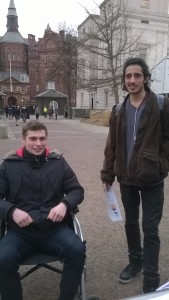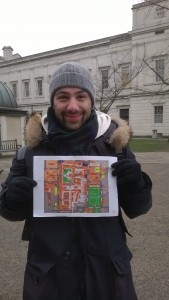
It may sound obvious to state that universities should be accessible. Of course, all education should take place in sites where everyone feels encouraged and able to participate, regardless of age, gender or background. However, there’s a more fundamental aspect to the term accessibility, but it’s one that is not always considered. This is the accessibility of a university’s built environment, and that is what UCL Try It! aimed to explore here in London.
In the course of everyday life, it’s very easy to become accustomed to the journeys you make, and simply take your mobility for granted. This is especially true of busy environments such as UCL’s Bloomsbury campus (or central London in general!) where everyone is charging around in a frenzied rush, willing to mow down anyone who dares to slow their quest for maximum efficiency.
Like many things in life, sometimes it’s useful to defamiliarise yourself from your everyday experiences to reconsider the things you take for granted. It’s not everyday that this is achieved by navigating the UCL campus in a wheelchair, but Try It! was one such day!
On February 12th Mapping for Change and members of UCLU Disabled Students took to the UCL Main Quad, huddled behind flasks of tea, snuggled cosily in our Try It! beanie hats, some even bopping from foot to foot to keep the numbness at bay.
Try It! offered UCL staff and students the opportunity to discover how accessible (or not!) the UCL campus really is for wheelchair users. A series of activities and challenges were designed by UCLU Disabled Students and Mapping for Change to raise awareness about disability, and get people thinking about what it’s like to navigate campus on two wheels.
For our challenge, we offered brave participants the choice of 7 different personas – all fictional UCL students, all wheelchair users, and all with a task to complete. Tasks were everyday scenarios: going to the refectory for a coffee, getting a book from the library, meeting some friends at a computer cluster; nothing too challenging, surely?
We asked people to draw the route they would take to get to these tasks onto a map, then to Try It! and attempt to carry out the route they had drawn as a wheelchair user (the fantastic UCLU Disabled Students’ Network had even managed to procure a couple of spare wheelchairs!). When they reached a point in the route that was inaccessible, they were asked to mark this on the map, then continue searching for an accessible path. When they had completed the journey, or realised that it was impossible on two wheels, they returned back to the main quad for us to discuss their experiences.
Generally, people were shocked by how difficult they found it, and amazed to discover that what they anticipated would be simple journeys of a few minutes, were actually closer to half an hour!
For many people, this was their first experience of using a wheelchair. As to be expected, it took a bit of getting used to:
“I found the task very tiring! You need lots of upper body strength!! Your arms get a real work out!”
Fitness aside, here’s what some people had to say about their experiences of accessibility:
“UCL needs more signposting to show accessible routes so people don’t waste their time going through a pointless route!”
“I found the challenge very sad! I went to the Physics building and tried to get to the first floor where the reception is, and it was IMPOSSIBLE! The challenge was very insightful.”
“The activity was illuminating. There are lots of systems around campus like barred doors in the museum seem to make a mockery of people’s attempts to get around.”
In general, the response was that, where accessible routes were available, it took a minor work of genius to locate them, but did not necessarily result in a seamless journey once they had been identified! One participant reflected that, due to this total lack of signage:
“You could spend all day trying to get somewhere!”
Although the ideal solution would be to revamp the UCL campus and make every building accessible from all angles by adding ramps, lifts and other features, this would be very costly and in some places impossible, given the historic architecture.
However, one very affordable yet hugely effective option would be to install maps and more thorough signposting. Signs would quickly let wheelchair users know which route to take. This solution will be discussed by Mapping for Change, UCLU Disabled students, and UCL estates – we hope to see many changes implemented!
Overall, despite the freezing temperatures, Try It! was a huge success! Plenty of awareness was raised about disability and accessibility at UCL, and Mapping for Change will be working hard to see some of people’s excellent suggestions become implemented on campus!
Mapping for Change would like to say a big thank you to Vicki Baars and Thines Ganeshamoorthy for organising the event, and to all of our fantastic participants who braved the cold and gave accessibility a try!


